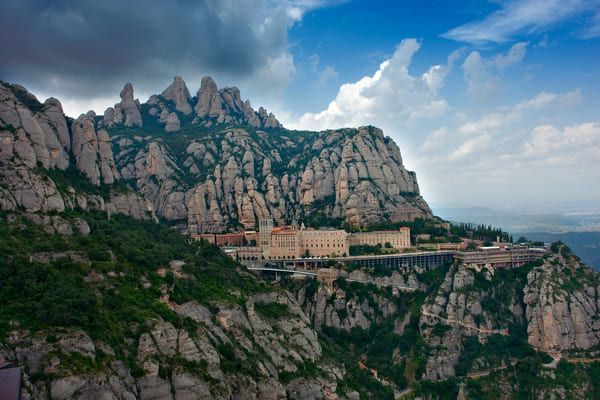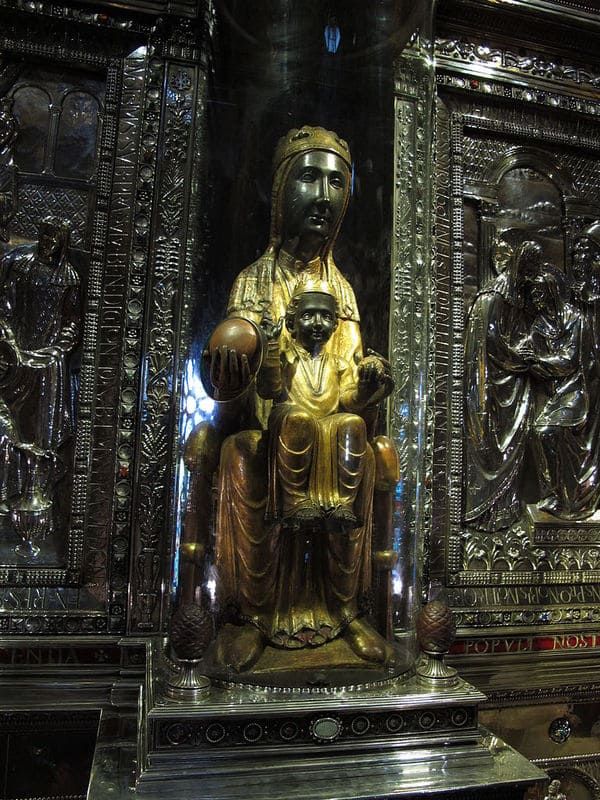Saint Josemaria had a strong devotion to Our Lady of Montserrat. Records exist of frequent visits made by him to the shrine of Our Lady of Montserrat near Barcelona, Spain, during the 1940s, especially towards the end of 1946, the year when he moved to Rome.
His love for our Lady under this advocation continued throughout his life. And it was on the feast of Our Lady of Montserrat, 27 April 1954, that he was cured of diabetes, after a severe allergic reaction which brought him to the point of death.

People who have had a brush with death, especially one involving loss of consciousness, often speak of seeing their lives pass before them, almost as if they were a spectator, yet aware that they are the protagonists.
On April 27, 1954, something like this happened to Monsignor Escrivá. It was the feast of Our Lady of Montserrat. Don Alvaro had, as usual, given him an injection five or ten minutes before lunch, but at a lower dosage than that prescribed and using a new kind of long-acting insulin. They went down to the dining room. Shortly after saying grace, as they sat facing each other, the Father suddenly said, “Alvaro! Absolution!” Don Alvaro tells what happened next:
I didn’t understand him. I just could not understand him. God permitted that I did not understand him. And then he repeated, “Absolution!” And for a third time—this was a matter of a few seconds, in all— “Absolution: ‘Ego te absolvo ...’” And at that moment he lost consciousness. I recall that first he turned a kind of purplish red and then an ashen yellow. And his body seemed to have become very small.
I gave him absolution immediately and did what I could. I called the doctor and put sugar in his mouth, forcing him, with water, to swallow it, because he was not reacting and I could not feel any pulse.
When the doctor — Miguel Angel Madurga, a member of Opus Dei — arrived, the Father had already regained consciousness. The shock had lasted ten minutes. Miguel Angel carefully examined him and confirmed that he was out of danger and there were no complications. The Father, in fact, seemed to have gotten well.
Indeed, he immediately started worrying about that son of his, Miguel Angel. Learning that he had not yet had lunch, he had him eat something, chatting with him all the while and giving no hint that he could not see.
“My son,” he said to Don Alvaro when the doctor had left, “it’s left me blind. I can’t see a thing.”
“Father, why didn’t you tell the doctor?”
“Because I didn’t want to worry him unnecessarily. This may just go away.”
He was blind for several hours. Then, gradually, his sight returned. When he could finally see himself in a mirror, he said, “Alvaro, my son, now I know how I’ll look when I’m dead.”
“You look as fresh as a daisy, Father,” Don Alvaro answered. “You should have seen yourself a few hours ago—you really did look like a corpse.”
Not only had he looked like a corpse, but he had seen his whole life pass by very quickly, as if in a movie. The founder, says Don Alvaro, told him that in that moment in which he saw his life pass before him, “he had had time to ask God’s forgiveness for all the things he felt were faults of his, including even some failures in understanding. For example, the founder thought the Lord had once given him to understand that he would die much later. And he begged pardon for this too—for not having understood him.”

He had been suffering from diabetes for about ten years. Now the metabolic disorders characteristic of diabetes speedily disappeared. His insulin treatment was discontinued.
Dr. Faelli, the specialist who treated him, situated the key moment of the cure precisely in the occurrence just described. “He was cured of diabetes,” the doctor stated, “after an allergic attack in the form of a skin eruption and a sudden loss of consciousness.” He emerged from the anaphylactic shock “cured of the diabetes and its complications; he never had any relapse; and he was no longer under any dietary restriction. It was a case of a scientifically inexplicable cure.”
Other witnesses support the statement that this was the day he was cured. For example, Encarnacion Ortega said: “On April 27, 1954, after being given some long-acting insulin and going into anaphylactic shock, he was suddenly cured of this illness. That same evening he told Maria Jose Monterde and me that because of all our praying, the Lord had heard us and had blessed him with a new stage of fruitfulness” (Sum. 5381).

“Some days earlier,” Bishop del Portillo says, “Dr. Faelli had prescribed a new type of insulin, indicating that the dosage should be 110 units. As always, I made it my responsibility to give him the injections. I was careful to read closely the leaflet that came with the medicine, and there it said the dosage should be lower than with regular insulin—about a third lower. For this reason, and because the higher doses of insulin greatly worsened the headaches that the Father suffered, I gave him a lower dosage than the doctor had ordered. Nevertheless, the medicine produced an allergic reaction of a kind I had never encountered before. I communicated this to the doctor, but he told me to keep using that insulin” (Alvaro del Portillo, Sum. 478).
(from Andres Vazquez de Prada, The Founder of Opus Dei, vol. III, pp. 172-173.)
